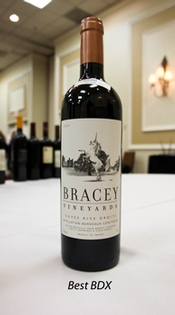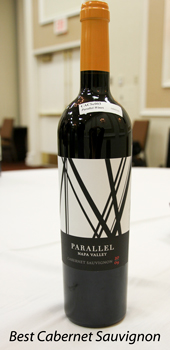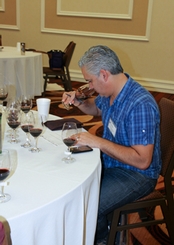Creators Syndicate
Once upon a time in American viticulture, it was fashionable — some would even argue necessary — to tag domestic wines with European place-names.
E&J Gallo, for example, had its uber-successful jug wine that it called Hearty Burgundy. And various sparkling wine producers, including Korbel and Schramsberg, often referred to their product as Champagne.
 Of course, the red wine of France’s Burgundy region is pinot noir, and it’s a good bet that that particular grape never found its way into a bottle of Hearty Burgundy. And the fizzy adult beverages being made in California and New York resembled authentic Champagne from France in only one sense: They had bubbles.
Of course, the red wine of France’s Burgundy region is pinot noir, and it’s a good bet that that particular grape never found its way into a bottle of Hearty Burgundy. And the fizzy adult beverages being made in California and New York resembled authentic Champagne from France in only one sense: They had bubbles.
Then there was the ubiquitous "Chablis" being sold throughout America. It seemed every white wine coming out of California was called Chablis, even though it might not have so much as a drop of chardonnay, the grape of the Chablis region of France.
It wasn’t that long ago that marketing strategy and sentiment shifted, and wines in the U.S. began to be labeled by the grape name. But that still presented an identity issue for winemakers who wanted to make blended red wines based upon another French model — Bordeaux.
Located in southwest France near the Atlantic Ocean, Bordeaux had long practiced the art of blending multiple grape varieties. The reason was commercial more than aesthetic. Some of the best grapes of Bordeaux, particularly the late-ripening cabernet sauvignon, would not fully ripen every vintage in the daunting climate of the region, where hail in summer and rain in autumn can be devastating to vineyards.
Five red grape varieties evolved over time as the principle grapes of Bordeaux: cabernet sauvignon, cabernet franc, merlot, petit verdot and Malbec, with cabernet sauvignon, merlot and cabernet franc holding the most important positions in the construct of Bordeaux viticulture.
With its access to world markets because of its proximity to the sea, Bordeaux over time became the world’s most prestigious wine. It was only natural, then, that when the wine boom hit California in the late 1960s, there was a stampede to plant the grapes of Bordeaux. Nothing sells like success.
But the question remained: What to call it? From this conundrum, the term "meritage" was born. Although many assume the word is French and attempt to give it a French pronunciation, the term was actually created by merging the words American and heritage, and the Meritage Alliance, headquartered in California, was born.
 Meritage wines are simply the Bordeaux-style blends created to replicate the wines of Bordeaux made from any combination of cabernet sauvignon, cabernet franc, merlot, petit verdot and Malbec grapes. The most famous meritage is perhaps the very first, Joseph Phelps Insignia, which has been around for three decades and pre-dates the term.
Meritage wines are simply the Bordeaux-style blends created to replicate the wines of Bordeaux made from any combination of cabernet sauvignon, cabernet franc, merlot, petit verdot and Malbec grapes. The most famous meritage is perhaps the very first, Joseph Phelps Insignia, which has been around for three decades and pre-dates the term.
Over the past weekend, I launched a new wine competition, Mainly Meritage, that was limited exclusively to wines made from the traditional grapes of Bordeaux. Mainly Meritage is a niche event that likely will never be huge in numbers, but it takes me back to my roots (it was my passion for Bordeaux that inspired my career as a wine journalist), and the quality of the wines submitted is guaranteed to be very high. For me, Mainly Meritage is a labor of love.
That high quality is assured at Mainly Meritage should be easy to understand. Most wineries that work with the Bordeaux grape varieties reserve their very best stocks for a Bordeaux-style blend, which in most cases is their flagship wine. Mainly Meritage was open to wineries that belong to the Meritage Alliance as well as wineries that simply make wine from the Bordeaux grapes.
Entries for the first Mainly Meritage were evaluated by winemakers, sommeliers and other wine professionals in a single day of judging that produced its share of surprises.
The winner of best BDX blend (BDX is a common reference for Bordeaux) was a garagiste wine from Bordeaux, the 2009 Bracey Cuvee Rive Droite, Bordeaux AOC ($105). Robert Bracey is an American who makes wine in Bordeaux, Burgundy and here in the United States. In fact, his 2006 Bracey Vineyards Cabernet Sauvignon, Howell Mountain, Napa Valley ($65) took the crown of Best Red Wine at the 2011 Sommelier Challenge International Wine Competition.
 Garagiste refers to the new generation of winemakers in Bordeaux who eschew the traditional chateau approach and make what are called "garage" wines. Bracey’s Cuvee Rive Droite emerged from a category for "right bank BDX blends." The so-called right-bank of Bordeaux, which includes the important AOC wines of Saint-Emilion and Pomerol, is dominated by merlot and cabernet franc, with very little cabernet sauvignon planted.
Garagiste refers to the new generation of winemakers in Bordeaux who eschew the traditional chateau approach and make what are called "garage" wines. Bracey’s Cuvee Rive Droite emerged from a category for "right bank BDX blends." The so-called right-bank of Bordeaux, which includes the important AOC wines of Saint-Emilion and Pomerol, is dominated by merlot and cabernet franc, with very little cabernet sauvignon planted.
The right-bank category at Mainly Meritage requires a wine to have less than 50 percent cabernet sauvignon. Bracey Cuvee Rive Droite is 73 percent Merlot, 23 percent cabernet franc and 3 percent cabernet sauvignon.
The Left Bank BDX was a tie between Napa Valley powerhouse V. Sattui, with its 2008 Paradiso ($65), and another wine from Bracey, the 2009 Cuvee Rive Gauche ($120). Left-bank blends at Mainly Meritage required a minimum of 50 percent cabernet sauvignon.
The Napa Valley also produced the winner of the award for best cabernet sauvignon, the 2009 Parallel Cabernet Sauvignon ($60), and scads of gold medals for big-hitters such as Cakebread Cellars, Pine Ridge Winery, Flora Springs, St. Supery Vineyards & Winery and Frank Family Vineyards.
Best Meritage was awarded to Washington’s Lake Chelan Winery for its 2008 Maximum 5, Columbia Valley ($45).
In something of a surprise, the Fallbrook Winery in Southern California took the top awards for both cabernet franc and sauvignon blanc
8
